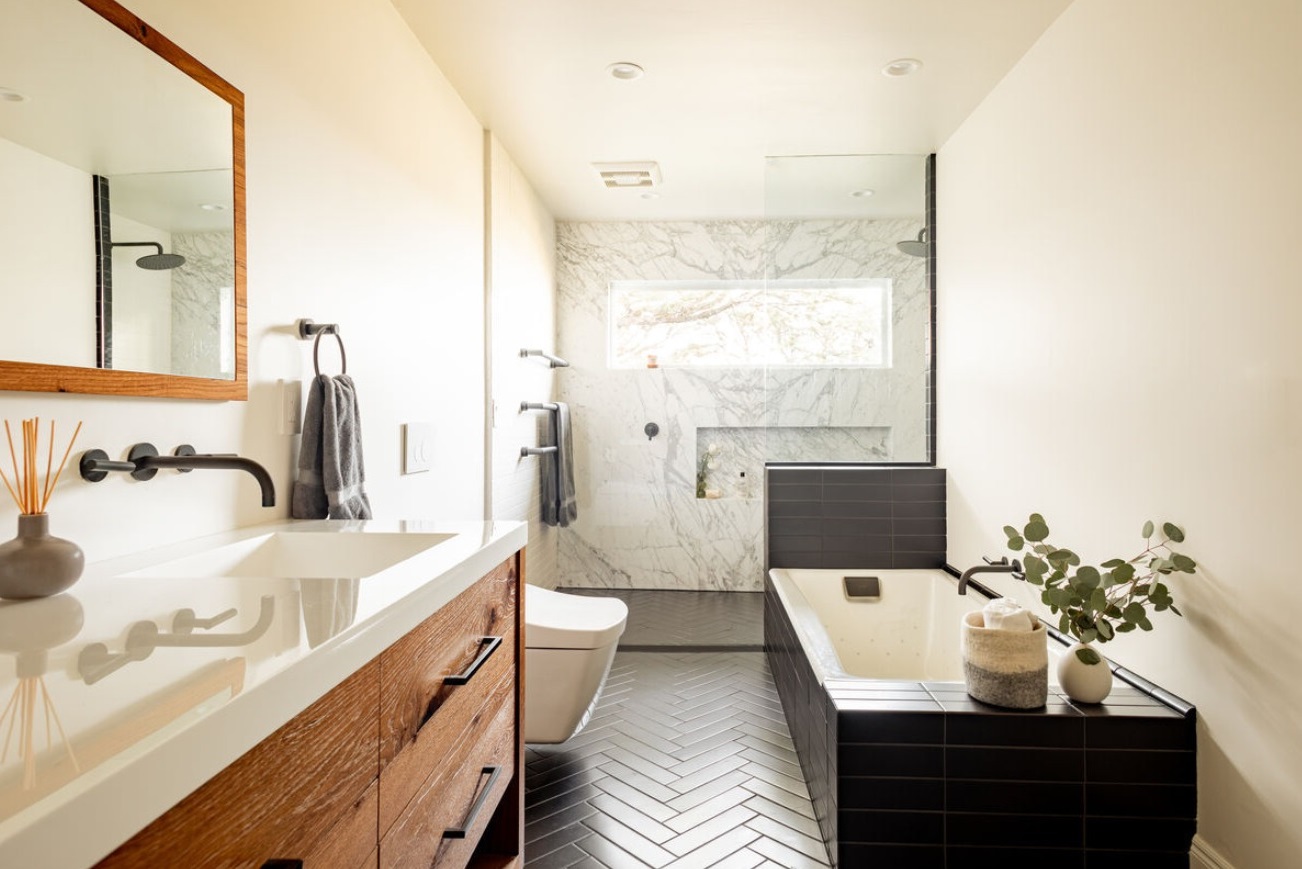No matter who you ask, then anyone has the different opinions about the tiles size that you use for your bathroom floor, especially if you want to make your small bathroom looks bigger. When choosing your tiles, there are some factors that you have to remember. Firstly, this is very important to consder the feel and look that you want to show off to your guest and most imprtant is feel and look that you want. Check these small bathroom flooring ideas below. Keep in miind that choosing right bathroom tiles is very subjective because anyone has their own needs, tastes and wants as well.
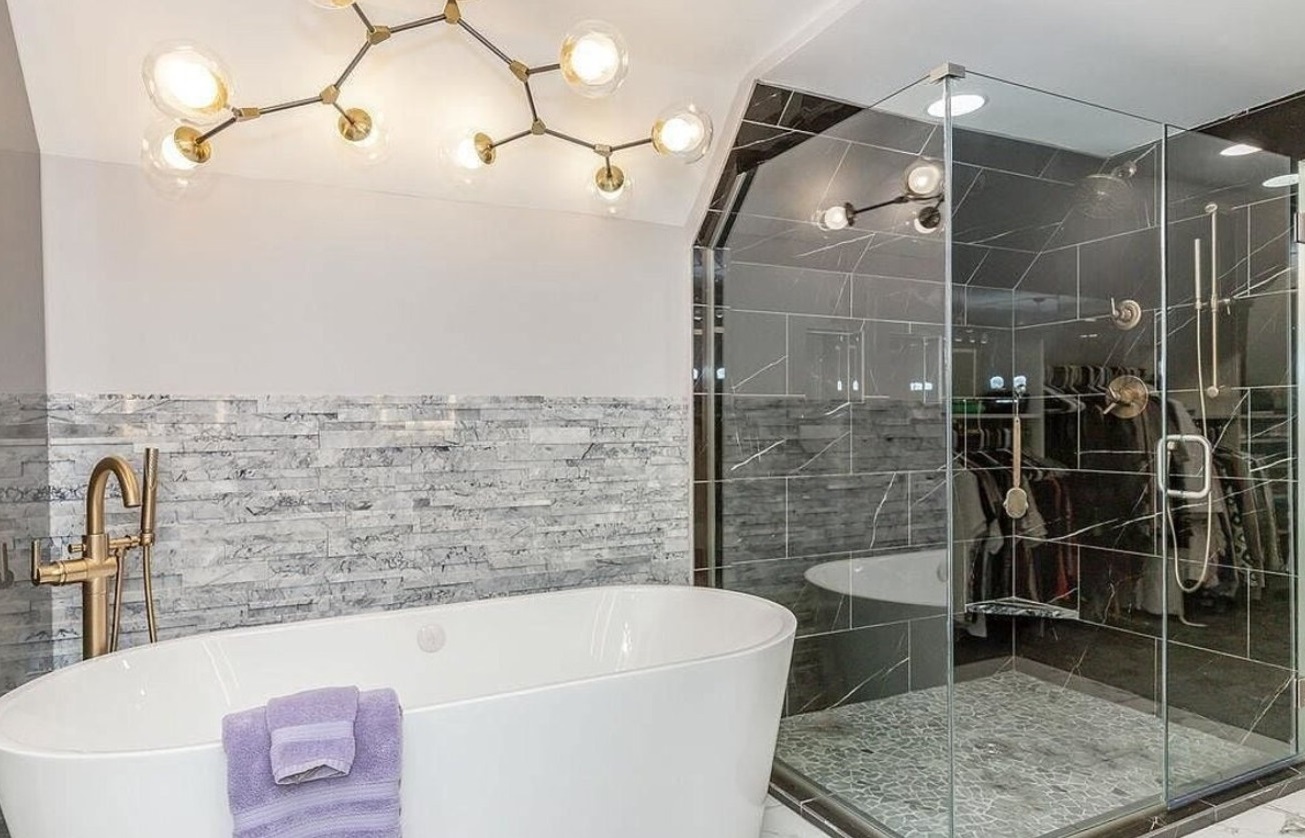
Consider the size
The bigger tiles, then the smaller the room that you will look as they said. In another hand, if you use the smaller tiles inside your smaller bathroom, there would be more grout lines which make your bathroom also looks small. So, what you have to do? You are able to use the medium sized tiles or you are also able to choose the larger tiles, ensure that it has the restricted edges and you can choose the grout color which matches with your overall design.
The color scheme of tile
It is also highly recommended that you can choose natural colors for your small bathroom. Choosing a brighter color for your small bathroom such as cream, light gray or white will help your bathroom looks bigger and thanks to tiles which reflect more light than the darker colors. The light tiles will allow your eye to flow out across the room and if you want to use them in the wall, then they will make your ceiling occurs higher as well.
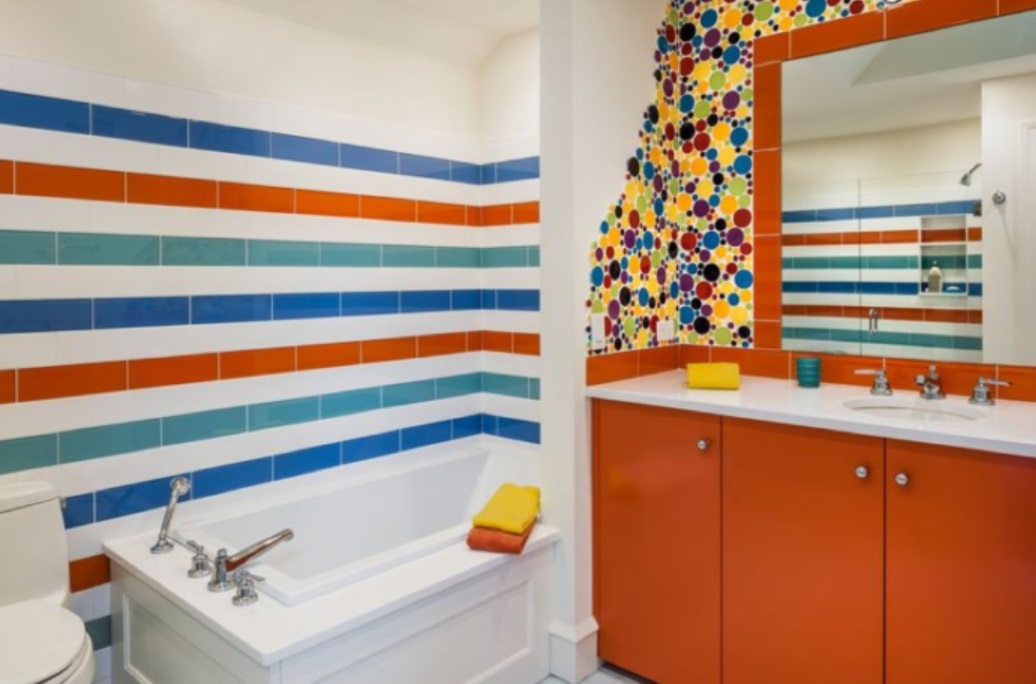
Right layout
To make your small bathroom looks bigger is placing your tiles in the diagonal line. You should know diagonal patterns will trick our mind to think that your bathroom is bigger than the reality. Another way to make your small bathroom looks bigger is installing the rectangular toles. If you install the rectangle tiles horizontally, then it will give an illusion that your wall is bigger than actually is. If you place the same tiles vertically, then you will make your space looks longer or higher.
The fixtures
The placement and choice of your fixtures can affect on how your small bathroom will look. So, if you have a small bathroom, installing big sinks, taps and more will make your room looks more cramped and crowded.
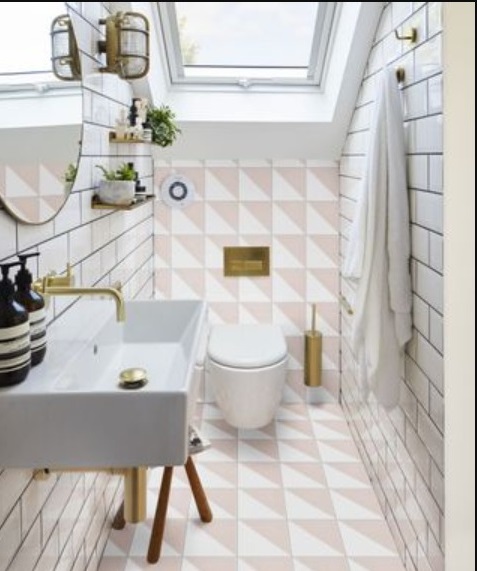
Tips for Effectively Cleaning Bathroom Floors
Floors can become yellow and hard to clean due to high humidity. To tackle this issue, utilize a waterproof coating product.
Apart from stubborn limescale, bathrooms often face other problems such as damp walls. An effective solution is to apply a waterproof coating to the bathroom walls. The use of waterproofing is essential to prevent moisture and minimize leaks. Some products also provide a glossy finish that is resistant to stains for easy cleaning. Waterproofing is a practical coating that helps resolve leaks and seepage in various areas of the house. As for dealing with floor limescale, consider the following tips.
Even though bathrooms are located indoors, it’s important to maintain their cleanliness. To prevent the floor from developing limescale, as it can be difficult to clean once it forms. If limescale has already formed, try the following tips.
Use Baking Soda for Cleaning
Baking soda is renowned for effectively cleaning limescale and stains from ceramic floors. Despite being primarily a baking ingredient, it’s commonly used for tackling tough stains.
Baking soda is readily available in the market and is also affordable, making it a practical choice for bathroom floor cleaning. For optimal results, follow these steps for cleaning the floor with baking soda:
Begin by evenly sprinkling baking soda powder on the stained and crusty floor surface.
Take a sponge and gently scrub the floor surface with the sprinkled baking soda.
Allow it to sit for some time before rinsing it with water.
Clean Tough Stains with Vinegar
In addition to baking soda, vinegar liquid is another food product that can help eliminate stains and tough patches on bathroom floors.
Aside from removing adhered dirt, vinegar liquid is also believed to have the ability to eradicate bacteria and germs in the bathroom. Here’s how to go about cleaning with vinegar:
Prepare vinegar and mix it with half a bucket of water.
Pour the lemon juice into a spray bottle.
Spray the mixture onto the stained area of the floor.
Allow it to sit for a while without scrubbing, then rinse it off with water.
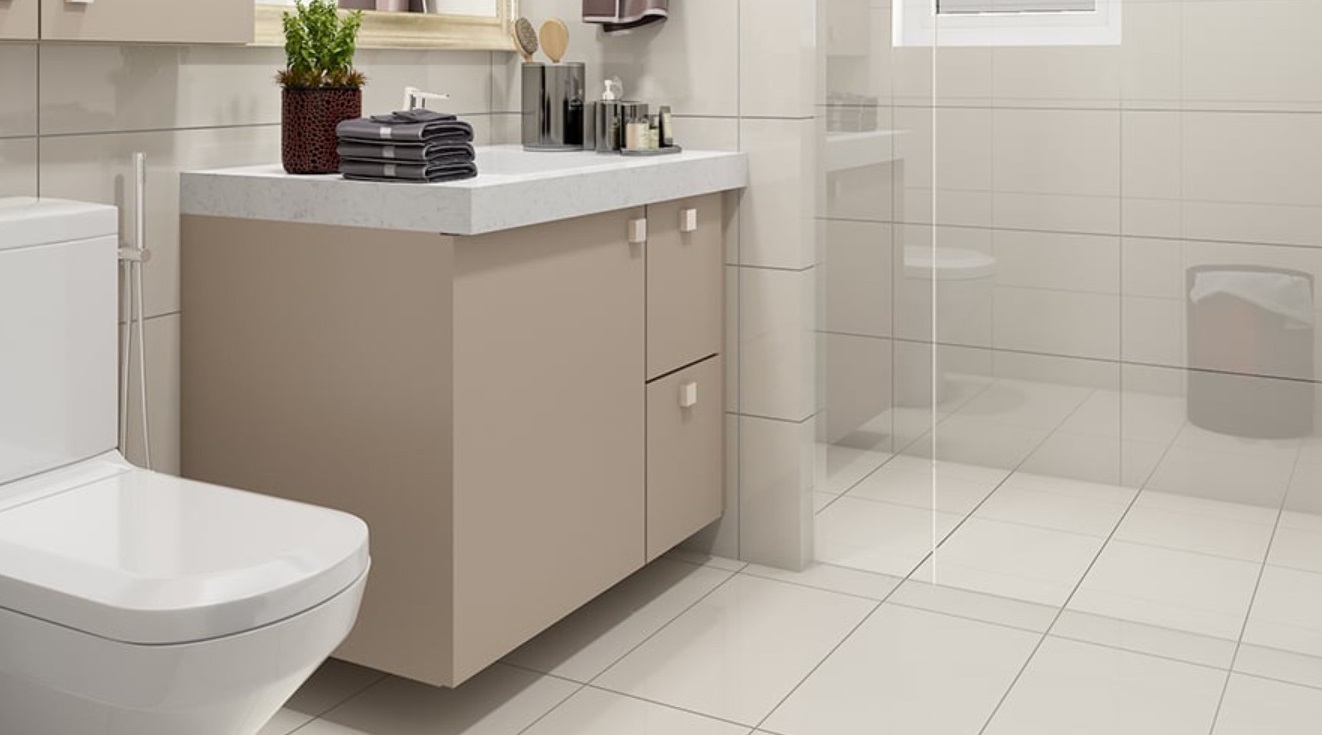
Utilize Lime Juice
Lime juice possesses various benefits, including the ability to remove stains and tough spots from bathroom floors. Here’s how to clean stained floors with lime juice:
Gather lime juice in a container.
Mix it with an ample amount of water and pour it onto the dirty bathroom floor.
Next, take a bathroom brush and scrub the stained surface until it’s clean.
Once all the stains are gone, rinse the floor surface with water.
Lemon Can also be Used
If you don’t have limes available, you can use lemon as a substitute for removing stains on the bathroom floor. Here’s how to use lemon for this purpose:
Squeeze the lemon to release its juice.
Transfer the lemon juice to a spray bottle.
Evenly spray it on the stained floor surface.
Take a floor brush and scrub the surface until the stains and tough spots are removed.
Clean the Floor with Chlorine
In addition to tough spots, bathroom floors can also develop a yellowish hue due to high humidity levels.
To address this issue, you can use waterproofing products to minimize humidity. Waterproofing coating not only reduces humidity but also prevents water from seeping through. If the floor has already turned yellow, attempt to clean it with chlorine by following these steps:
Boil water in a pot.
Carefully pour the boiling water onto the bathroom floor, ensuring it doesn’t come into contact with your feet.
Subsequently, evenly sprinkle chlorine powder on the floor.
Allow it to sit for 30 minutes, then scrub with a brush until it appears clean, and rinse with cold water.
Citric Acid Can Help with Bathroom Floor Stains
To prevent yellowing of the bathroom floor, it is recommended to apply a waterproof sealant between the grout lines. Waterproofing helps to control the humidity levels in the bathroom. Additionally, it is essential to clean the floor regularly to address any stains or buildup.
It’s crucial to address the issue promptly, as it becomes tougher to clean once it worsens. Citric acid powder can be used to tackle this problem. Here’s how to clean bathroom floors using citric acid:
Prepare citric acid powder and mix it with water while stirring until dissolved.
Once dissolved, pour the citric acid solution onto the stained floor surface.
Use a brush to remove the stains and buildup. After cleaning, wash the floor with water.
Going forward, apply a waterproof sealant in the bathroom to prevent moisture. Damp bathroom floors can easily turn yellow and become a breeding ground for bacteria and fungi.
Using Salt Solution
Aside from adding flavor to food, salt is also effective for cleaning dirty bathroom floors. Here are the steps:
Prepare two tablespoons of salt and dissolve them in two liters of water.
Heat the solution in a pan until it boils.
Carefully pour the hot salt solution onto the soiled floor surface.
Use a floor brush to scrub the dirty areas until clean, then rinse the floor with water.
Utilizing Chlorine for Stubborn Stains
Chlorine is commonly found in disinfectant products and can effectively tackle limescale and stains quickly. Here’s how:
Prepare hot water and chlorine liquid in a spray bottle.
Pour hot water over the affected floor surface and evenly spray the chlorine liquid.
Allow it to sit for 30 minutes.
Then, scrub with a brush until the stains are lifted and rinse with cold water.
Using a Liquid Scale Cleaner
The final method to clean the bathroom floor is by using a scale cleaner available in the market. Here are the steps:
Dissolve the liquid cleaner in water as per the instructions on the packaging.
Evenly pour the solution onto the soiled floor surface and scrub to lift the dirt.
After removing the stains and buildup, rinse thoroughly with water.
Conclusion
Now, there’s no need to worry about removing tough floor stains in the bathroom. You can utilize the aforementioned tips. Regular cleaning and maintenance are crucial to preserve the bathroom’s condition.
Applying a type of waterproof sealant to the gaps between the floor grout and bathroom walls is a necessary maintenance step.

How to Quickly and Efficiently Clean a Bathroom
Cleaning a dirty bathroom is not something anyone looks forward to, but breaking the task into smaller parts and using the right tools and techniques can make it more manageable. Here are 10 steps for a cleaner, fresher bathroom.
- Clear surfaces.
Remove shower and tub products, as well as items from the sink. Remove the trash can, towels, and rugs.
- Dust the room.
Eliminate dust, dirt, and cobwebs from corners and often overlooked areas like blinds and around windows, including the baseboards.
- Clean and rinse the shower or tub.
Use a shower/tub cleaner or a multi-purpose solution to gently scrub away dirt and grime from the surfaces before rinsing. Wipe down any glass shower doors with a glass cleaner.
- Clean the sink and counter/vanity area.
Apply a multi-purpose cleaner to the faucets, basin, and countertops, and wipe them with a cloth. Scrub and wipe any buildup in the soap dish and sink. Use a glass cleaner to clean the mirror.
- Ensure the toilet is spotless.
Apply toilet cleaner inside the rim and bowl. If you clean the inside of your toilet regularly, you can use an all-purpose cleaner. Use a toilet brush to scrub and then flush. Spray the all-purpose cleaner on the rest of the toilet and wipe it down with a clean cloth.
- Use a multi-step approach to clean the bathroom floors.
Start by picking up items like baskets, towels, and toilet plungers. Next, sweep up any dust that has accumulated on the floor, especially in the corners of the room.
Then, use a vacuum to eliminate any remaining debris. Afterwards, mix warm water with an all-purpose cleaner in a bucket. Mop the floor and once done, make sure the bathroom is free of people long enough for the floor to dry.
- Organize and clean items before placing them back.
Go through any baskets you took off surfaces and quickly organize the items inside. Clean the products such as shampoo and conditioner bottles.
- Arrange items neatly in their designated places.
Arrange bottles, baskets, and other items neatly in the shower or tub, on the sink/vanity, or on the shelves where they belong. If you find products or items that you haven’t used in a long time, store them in a cabinet or discard them. There’s no need to keep unused containers around, cluttering the tub or sink area.
- Take preventive measures to avoid stains and marks.
To prevent stains on a daily basis, periodically lift up containers and wipe the surfaces they were resting on. Using a drain cover can prevent rings caused by slow-draining water, and wiping down the tub/shower walls after each use can keep them streak-free.
- Establish regular habits to maintain a clean bathroom.
Put things away as you use them. Use bins and baskets to store smaller items and prevent clutter. Sweep up hair, dust, and dirt from the floor every day.
Bathroom Cleaning Services
If you prefer to have professionals handle bathroom cleaning, you can reach out to a bathroom cleaning service in your area. We have locations across the United States. Their service takes care of bathroom cleaning, leaving your bathroom fresh and clean, so you can focus on other tasks.
They use proven and effective cleaning methods to ensure satisfactory results. They clean items in your shower and use highly effective bathroom cleaners. Additionally, they thoroughly clean the tub and shower, leaving the bathroom fixtures sparkling and removing any soap residue or buildup. Mirrors, chrome, and tiles are cleaned, dried, and polished to perfection. Your vanity and sink are thoroughly cleaned. They also scrub the entire toilet, both inside and out. Finally, they sweep and mop the floors and empty the trash cans.
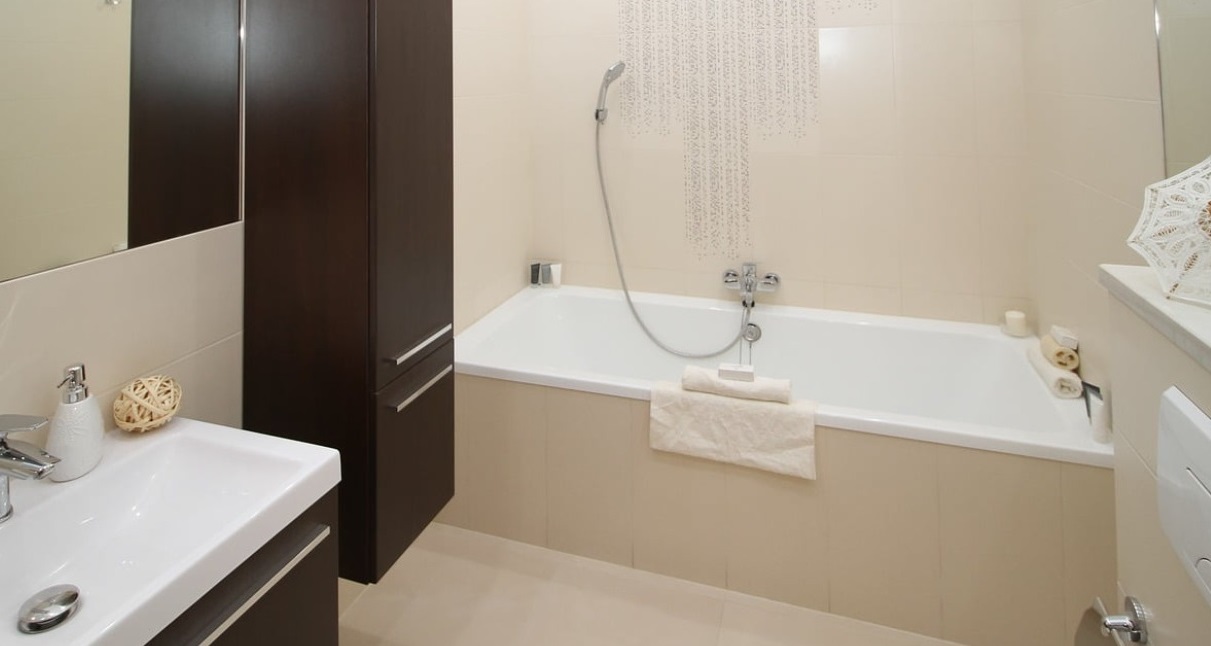
The Advantages of Bathroom Cleaning Services
Professional bathroom cleaning services offer numerous benefits. First and foremost, they save you valuable time and energy, allowing you to focus on other responsibilities. Their experienced team has the expertise and tools to comprehensively clean your bathroom, ensuring a hygienic environment. They can tackle stubborn stains and eliminate hidden germs, promoting a healthier living space. A well-maintained bathroom enhances the overall look of your home, making it a welcoming space for residents and guests. With regular cleaning services, you can sustain a consistently clean and fresh bathroom without having to do everything yourself.
Causes of Scale on Bathroom Ceramics
Scale that appears on bathroom floor or wall ceramics can be caused by several factors.
By identifying the cause, you can apply the appropriate treatment for bathroom scale. The causes are as follows:
- Soap Residue
As a room primarily used for soap, soap residue is a common cause of scale on bathroom ceramics. If not thoroughly rinsed or flushed, soap residue can settle on the ceramic surface and react with the mineral content in the water, forming a stubborn scale that is difficult to remove. This risk becomes even greater if the water in your home has a high level of hardness.
- Fungi and Moss
The consistently damp conditions in the bathroom create higher humidity levels compared to other areas in the house. This increased humidity makes the bathroom particularly prone to mold and moss growth. Both can thrive on the bathroom floor and walls. When mold and moss develop on ceramic surfaces, they can lead to stubborn black spots. Over time, these spots can harden into a crust, making the bathroom look unsightly and unclean.
- Grime
Various types of dirt from outside the house, such as dust, sand, soap particles, and other debris, may find their way into the bathroom. These particles can be tracked in by individuals during showering, or they can be carried in through the bathroom ventilation system. When dirt adheres to bathroom ceramics, it can contribute to the formation of limescale. If not cleaned regularly, external dirt can accumulate and create a resilient layer that is challenging to remove.
